Official Name:
Wabar is the official name of this meteorite. It was found where legend says a mythical city of the same name once stood. Synonyms for the meteorite's name include al-Hadida, Nejed, and Wade Banne Khaled. These names designate real geographical places near the fall site.
Location:
The meteorite fell in one of the most hostile places on the surface of the Earth: the Rub' al-Khali Desert, or Empty Quarter, in Saudi Arabia. The meteorite was found 550 kilometres from the capital city of Riyadh.
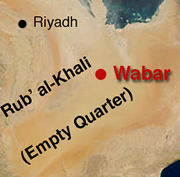
Enlargement
The Wabar craters are in the eastern part of the desert of Rub' al-Khali. |
|
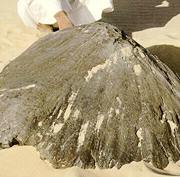
Enlargement
The Bedouin guide who led researchers to the Wabar meteorite's main mass. |
|
Fall or Find:
Wabar is usually classified as a find. In the middle of the 19th century, a mass of iron was seen falling from the sky. But if this is true, it must have been a different meteorite, because the Wabar craters date from before the 19
th century.
Date:
The first fragment was probably found in 1863. Recovery of the other masses of iron stretched out over a one-hundred-year period.
Mass Recovered:
So far, the meteoritic material that has been collected totals 2 533 kilograms, but other iron masses may still lie sleeping snugly under the desert dunes.
Number of Fragments:
The Wabar craters yielded many meteorite fragments. The main fragment is cone-shaped and has a mass of 2 040 kilograms.
Strewn field:
The craters are grouped together in an area measuring 1 000 by 500 metres.
Crater:
The British explorer Harry St. John Philby decided to cross the Rub' al-Khali in 1933 to look for the legendary city of Wabar. He had heard that a huge mass of metal, perhaps an ancient statue, would mark the site of the city. After walking for two months, instead of ruins, he found two craters, with no trace of a metal artifact. He discovered irregular masses of black and white glass around the impact structures. Back in England, analyses revealed that the masses contained countless globules of iron and nickel-impactites. These impactites confirmed the craters' meteoritic origin.
In addition to the two structures that were visible when Philby was there, certain clues led him to believe that there might be three more craters buried under the sand. During a scientific expedition in 1995, Eugene Shoemaker made a map of three impact craters. The biggest one is 116 metres in diameter, the second biggest is 64 metres, and the last one is 11 metres. The number of craters varies from one expedition to another, because the smaller craters are periodically buried and then swept clear again by the wind. Shoemaker estimates that the impact structures were created between 300 and 600 years ago.
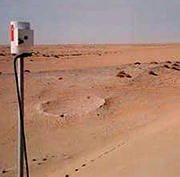
Enlargement
The smallest Wabar crater currently visible measures 11 metres in diameter. |
|
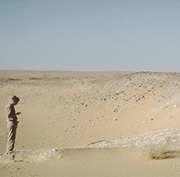
Enlargement
One of the big Wabar craters. Its rim is scattered with white impactites. |
|
Circumstances:
A 59.4-kilogram mass from the Wabar meteorite was discovered in 1863 and sold to the Natural History Museum in London, England. Another mass was found in 1893 and sold. In 1965, a team from the Aramco Oil Company recovered the enormous iron meteorite that Philby had heard about. When Philby's expedition was there, the iron mass must have been temporarily buried under the sand. Finally, 200 kilograms of meteoritic matter were found in 1966.
Just as legend said, the main mass is as big as a camel's hump. It has a diameter of 1.07 metres and measures 0.60 metres in height. Its cone shape and flat base suggest an oriented fall through Earth's atmosphere.
History:
One of the most important relics in the Muslim world is the sacred black stone of Kaaba. It has been venerated for over 1 500 years. Today exhibited in Mecca, this stone bears a strong resemblance to the impactites from the Wabar craters, but because the Wabar craters are much younger than the black stone of Kaaba, it probably didn't come from there.
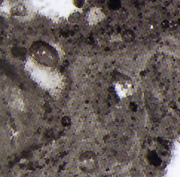
Enlargement
Impactite from the Wabar craters. It is made of sand and meteoritic matter that melted and mixed when the meteoroid hit. |
|
Type:
Iron meteorite
Class:
Medium octahedrite (0.9-millimetre bands)
Group:
IIIAB
Composition:
Wabar is mainly composed of iron. This metal accounts for 92.5% of the meteorite's volume, followed by nickel and cobalt, at 7% and 0.29%, respectively.
Scientific contribution:
Judging from the size of the craters, the meteoroid must have had a diameter of at least 4 metres and weighed 300 metric tons. The impact released energy equivalent to the explosion of 1 000 tons of dynamite.
Comments:
Wabar is one of the youngest impact craters on Earth.
Part of the Planétarium's collection:
Yes